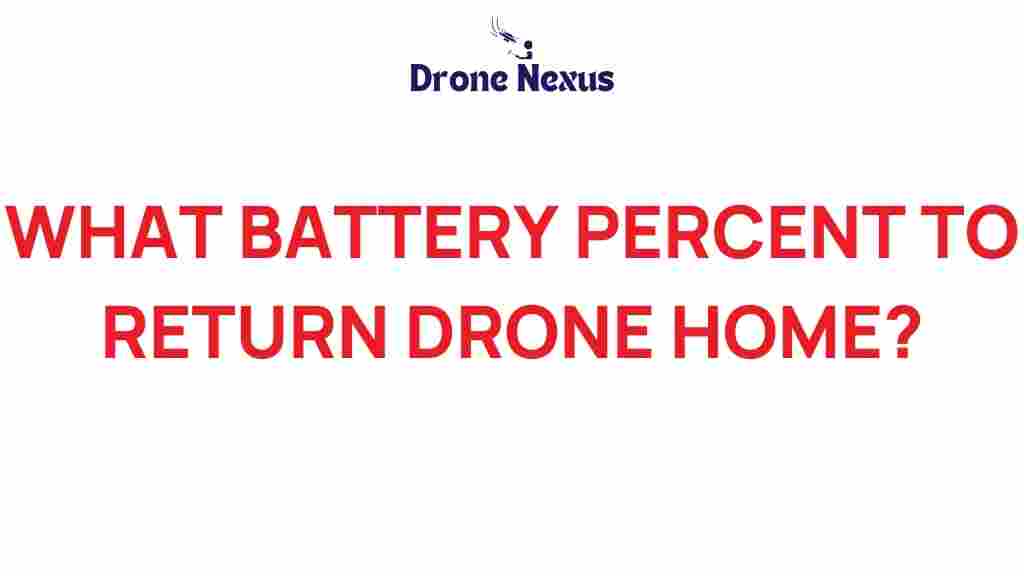What Battery Percent Should You Return Your Drone Home?
When flying a drone, one of the most critical factors to consider is the drone battery life. Understanding when to return your drone home is essential for ensuring its safety and functionality. This article will guide you on the optimal battery percentage to consider when making the decision to bring your drone back, along with tips and best practices for battery management.
Understanding Drone Battery Life
The drone battery is a vital component that determines how long your drone can stay airborne. Most consumer drones operate using lithium-polymer (LiPo) batteries, which are known for their high energy density and lightweight properties. However, these batteries need to be monitored closely to avoid unexpected shutdowns during flight.
Factors Affecting Drone Battery Life
Several factors can influence the longevity of your drone battery during a flight:
- Weight: The total weight of the drone, including additional accessories, affects battery consumption.
- Flight Conditions: Wind speed and weather conditions can lead to increased battery drain.
- Flight Style: Aggressive maneuvers and rapid ascents can reduce flight time.
- Battery Health: Older or damaged batteries may not hold a charge effectively.
When to Return Your Drone Home
Deciding when to return your drone is crucial for preventing it from crashing due to low battery levels. Here’s a simple guideline:
Optimal Battery Percentage for Return
It is generally recommended to begin your return when your drone battery level reaches around 30% to 40%. This percentage is a safe threshold that allows for a buffer during your return journey. Here’s why:
- Safety Margin: Returning at 30% provides a buffer in case of unexpected delays or longer flight times.
- Battery Discharge Rate: Drones can experience a rapid discharge rate, especially during maneuvers.
- Return-to-Home (RTH) Function: Many drones come equipped with an RTH feature that activates when battery levels are critically low. However, it’s best to avoid relying solely on this feature.
Calculating Flight Time
Before taking off, it’s essential to calculate your expected flight time based on your drone battery specifications. Most drones provide an estimated flight time based on optimal conditions. Always plan to return home well before your battery reaches its critical level.
Step-by-Step Process for Managing Your Drone Battery
To ensure a smooth flying experience and avoid battery-related issues, follow these steps:
1. Pre-Flight Checks
- Check the battery health and ensure it is fully charged.
- Inspect the drone for any physical damage.
- Update firmware if necessary to ensure optimal performance.
2. Monitor Battery Levels During Flight
Keep an eye on your drone battery percentage throughout your flight. Most drones display real-time battery information on the controller or mobile app.
3. Establish a Return Plan
Before you take off, plan your route and identify landmarks that will help you navigate back safely once your battery reaches the designated percentage.
4. Use the Return-to-Home Feature Wisely
Set your RTH altitude before takeoff. This ensures that your drone can ascend safely above obstacles on its way back home.
5. Practice Makes Perfect
Consider practicing flying back to your launch point at various battery levels to gain experience and confidence in your drone’s capabilities.
Troubleshooting Common Drone Battery Issues
Even with careful planning, you may encounter issues with your drone battery. Here are some common problems and solutions:
1. Rapid Battery Drain
If your drone’s battery depletes faster than expected, consider the following:
- Check for software updates that may improve battery efficiency.
- Ensure your drone is not overloaded with unnecessary accessories.
- Assess your flying style and avoid aggressive maneuvers.
2. Inaccurate Battery Readings
If you notice discrepancies in battery readings:
- Calibrate your battery settings according to the manufacturer’s guidelines.
- Inspect the battery connectors for dirt or damage.
3. Battery Swelling
A swollen battery is a sign of a failing drone battery. If this occurs:
- Stop using the battery immediately and store it in a safe location.
- Dispose of the battery according to local regulations.
Best Practices for Drone Battery Maintenance
To extend the life of your drone battery and ensure optimal performance, consider these best practices:
- Store batteries in a cool, dry place and avoid extreme temperatures.
- Charge batteries using the manufacturer’s recommended charger.
- Do not let the battery discharge completely; aim to keep it between 20% and 80% charged.
- Perform regular maintenance checks on your battery and drone.
Conclusion
Understanding when to return your drone home based on the drone battery percentage is crucial for safe and successful flights. By monitoring your battery levels, establishing a safe return plan, and adhering to best practices in battery management, you can significantly enhance your flying experience. Always remember to prioritize safety and maintain your equipment for optimal performance. For more information on drone safety and battery management, visit Drone Flying Safety Tips. Stay informed and enjoy your flights!
This article is in the category Safety and created by DroneNexus Team

1 thought on “What Battery Percent Should You Return Your Drone Home?”